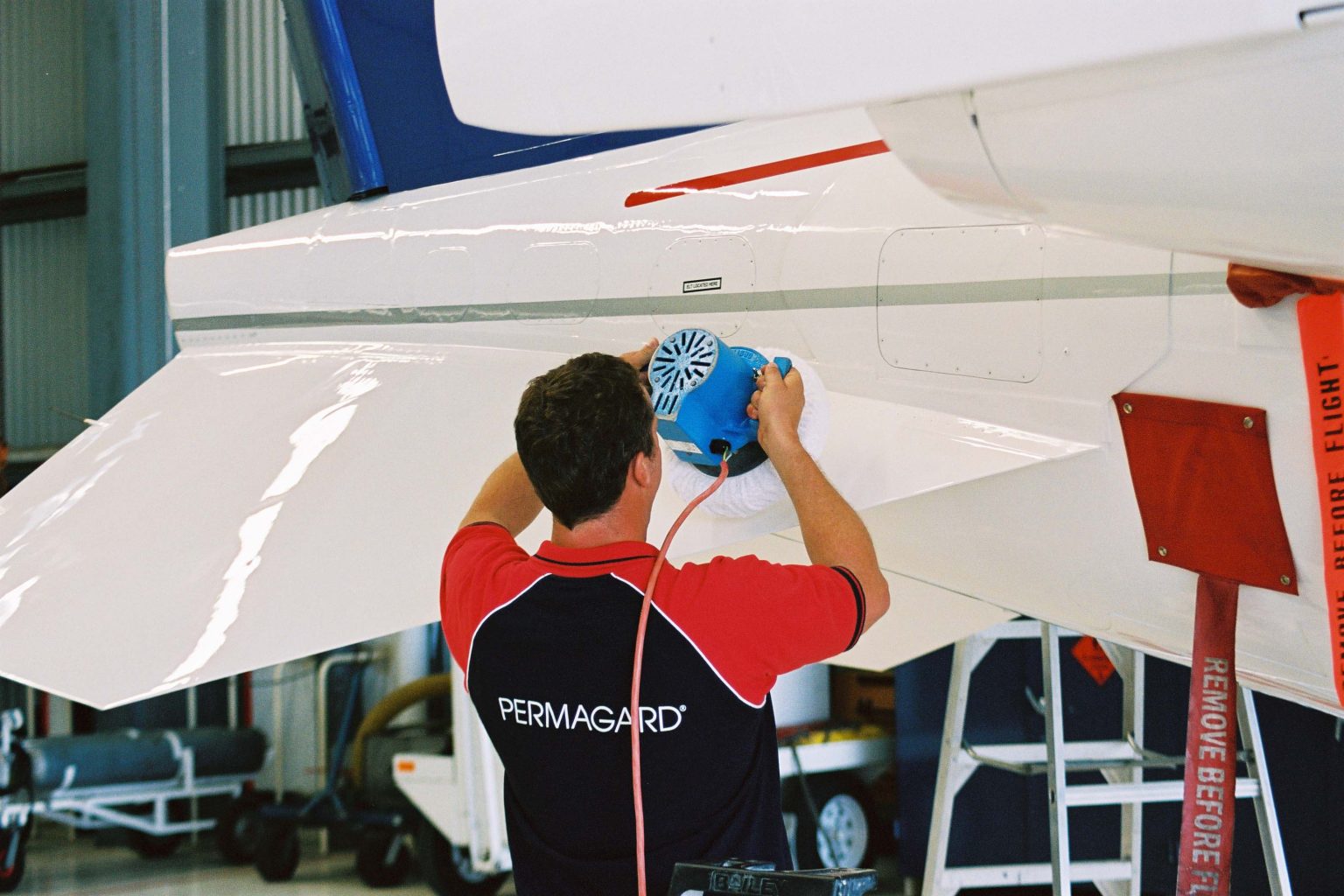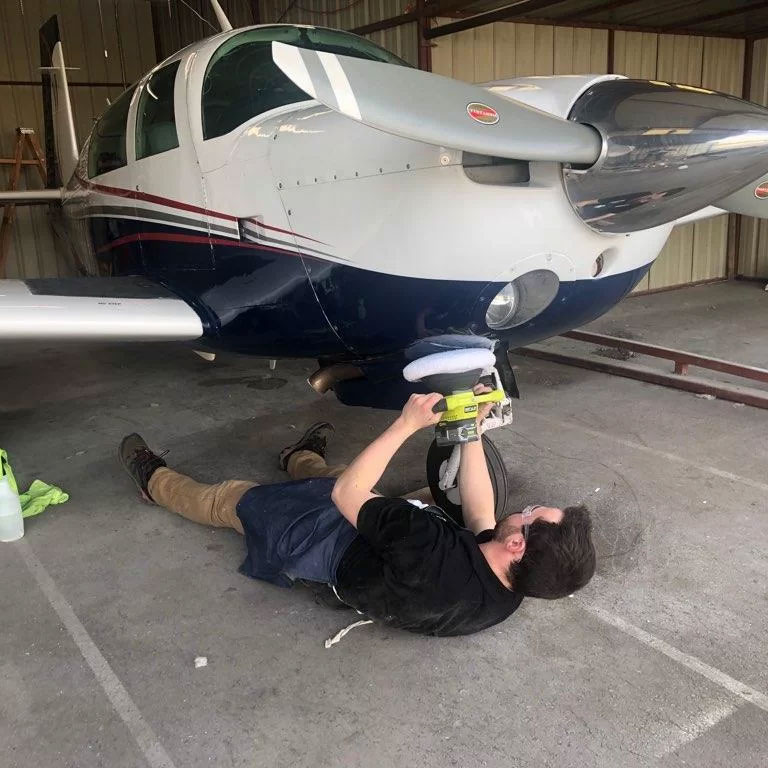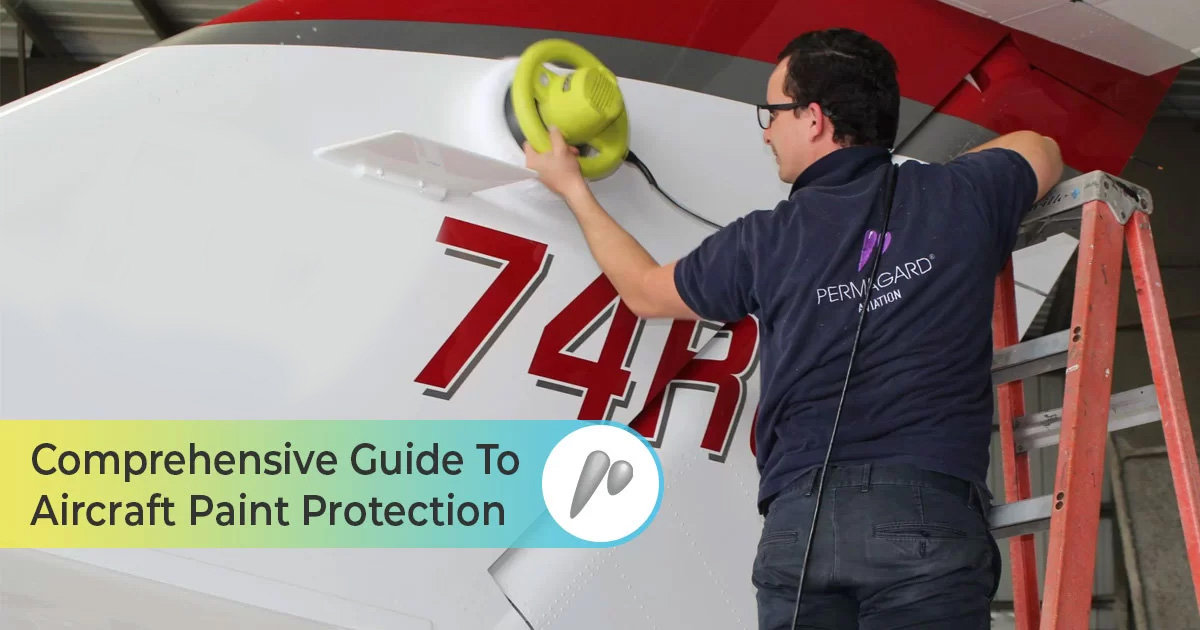Aircraft are extremely costly investments that require meticulous care and maintenance. Maintaining their appearance with Permagard is key to helping retain their value. The type of aviation paint protection used is a crucial aspect to consider. The constant exposure to various environmental elements such as UV rays, humidity, acid rain, pollutants, and mechanical abrasion, can quickly degrade an aircraft’s paintwork. This article will explore how Permagard, a leading provider of aircraft paint protection coatings, ensures that your investment remains pristine for years to come.
What is Permagard?
At Permagard, we strive to be the global leader in the development and application of aircraft paint protection coatings. With decades of experience in the aviation industry, our company has established itself as a trusted partner for aircraft owners and operators worldwide. What sets us apart from other paint protection solutions is the use of our advanced coating technology. This innovative approach allows our highly flexible coatings to create a strong molecular bond with painted surfaces, forming a permanent, durable barrier that shields against environmental attacks.
Various Environmental Factors that Can Degrade Aircraft Paint
Before diving into the solutions that Permagard provides, it’s crucial to understand the adversaries that aircraft paint can face on a daily basis:

UV Radiation
One of the primary causes of paint degradation on aircraft is exposure to harmful ultraviolet (UV) radiation. The high-altitude environment in which aircraft operate leads to increased UV intensity, accelerating the fading and discoloration of paintwork. The sun’s harmful rays not only cause your aircraft’s paint to oxidize and fade but also break down the chemical bonds within the paint, leading to its deterioration.
Acid Rain
In some regions, acid rain is a common occurrence due to industrial emissions and other pollutants present in the atmosphere. Acid rain contains chemicals, such as sulfuric acid, that can corrode and damage an aircraft’s paintwork. If left unattended, these elements can severely damage aircraft paint, resulting in discoloration, peeling, and even structural damage.
Mechanical Abrasion
Aircraft are exposed to various mechanical forces during operation and maintenance. Whether it’s routine cleaning, maintenance equipment contact, or bird strikes, these incidents can cause scratches or physical damage to a plane’s exterior. Over time, such abrasions weaken the overall integrity of the paintwork and may require more substantial repairs.
De-icing Chemicals
De-icing and anti-icing chemicals can degrade your aircraft’s paint over time. If they are required to be used, Permagard has no adverse effects on the application of these chemicals, and it will not affect Holdover Times.
Humidity
Another environmental factor that poses a significant threat to aircraft paint is humidity. Moisture in the air can seep into microscopic pores or imperfections in the painted surfaces, causing them to swell and peel. High humidity levels can also lead to corrosion on metal surfaces, further compromising the integrity of an aircraft’s exterior.
Pollutants
Airborne pollutants such as dust, dirt, and chemicals from industrial activity can settle onto the surface of an aircraft. These particles constantly dirty all aircraft, and act as abrasive agents that can scratch or dull the paint’s finish when friction becomes present. Additionally, certain contaminants may have corrosive properties that can erode and damage the clearcoat and basecoat on aircraft paint jobs.
Salt-laden Air
Salt-laden air from coastal regions and winter runways can cause corrosion to occur. Permagard will protect the integrity of your paint, which will reduce the costly effects of corrosion.
Runway Grime
Runway grime and wet runways will dirty your aircraft. A dirty aircraft can impact performance and may increase fuel costs and drag.
How Permagard’s Protective Coatings Act as a Shield Against These Elements
Permagard understands the challenges that aircraft owners face in maintaining the pristine condition of their investment. To combat these environmental factors, we have developed the gold standard in aviation paint protection coatings that act as an effective, durable shield to fully protect your aircraft’s paint. Here is how our coatings function:

Protects Against Fading & Oxidation
Permagard’s protective coatings are specifically designed to combat the damaging effects of UV radiation. By forming a strong molecular bond with the aircraft’s paintwork, our aviation paint protection creates a permanent protection barrier with painted surfaces to reflect harmful UV rays, preventing them from infiltrating your clearcoat and basecoat. This shield significantly reduces color fading and oxidation, keeping your aircraft looking vibrant and fresh.
Eliminates Swirl Marks
Swirl marks and micro-scratches on aircraft surfaces are a significant issue. Permagard’s protective coatings are formulated to eliminate these imperfections by filling in micro-scratches and creating a smooth, high-gloss finish. Our advanced technology allows the coating to self-level and create an even surface, effectively minimizing the appearance of scratches caused by abrasive contact.
Prevents Corrosion
Our aircraft paint protection solution provides an effective barrier against moisture and corrosive elements. It creates a smooth surface that repels water, preventing it from etching into the paint and causing corrosion on metal surfaces. It also has chemical resistance properties that help protect against damage caused by acid rain or other pollutants. Permagard is the best protection for your aircraft’s paint, enabling your paint to protect the substrate of your aircraft.
Does Not Contain Wax or Silica
While traditional waxes and silica-based products may provide temporary shine, they can cause long-term damage to aircraft paint. Wax can attract dust and dirt particles, leading to an abrasive effect on the painted surface during cleaning. On the other hand, silica-based products create a hardened surface that degrades significantly over time, causing repainting issues and long-term basecoat damage. Permagard’s aviation paint protection coatings do not feature these ingredients, offering long-lasting protection without compromising the integrity of the paintwork and without changing the specification of your aircraft’s paint.
The Benefits of Permagard’s Aircraft Paint Protection
Permagard’s aviation paint protection coatings offer various benefits for aircraft owners, including the following:

Directly Applicable to New Paint
Aircraft owners can have our advanced coating applied directly to new paint. This allows them to care for their investment from day one proactively. There is no need to worry about their paintwork being vulnerable to environmental factors as soon as it leaves the manufacturer. Having Permagard applied to a new aircraft is the ideal moment to protect it. You only get one chance to protect your new aircraft.
Permagard Applied to Used Aircraft
Although the ideal time to Permagard an aircraft is on newly painted surfaces, not everybody has the opportunity to have Permagard applied to new paint. Therefore, Permagard can also be applied to used paint, or even dull paint. Permagard’s effect on used paint is highly beneficial, and it will stop the vicious cycle of paint degradation, allowing you to keep your existing paint for years to come.
Permagard can also be safely applied to matte paint, decals, and paint protection film.
Environmentally Friendly
Permagard is committed to environmental sustainability. Our aviation paint protection coatings are free from harmful chemicals that can negatively impact the environment. Additionally, its long-lasting durability reduces the need for frequent repainting, resulting in less waste and a reduced carbon footprint. It also makes Permagarded aircraft easier to clean using highly diluted water cleaners.
Provides Durable Protection
Permagard’s protective coatings offer a high-performance solution that provides durable protection for aircraft paintwork. Our advanced coating technology creates a strong molecular bond with painted surfaces, forming a resilient barrier against UV radiation, humidity, acid rain, pollutants, and mechanical abrasion.
Slows Paint Deterioration
By acting as a shield against UV radiation, our advanced coating effectively eliminates the deterioration of aircraft paint. This helps to maintain the vibrant appearance of your aircraft for many years and reduces the need for frequent repainting.
Easy Maintenance
The water-repelling properties of Permagard’s aircraft paint protection make the aircraft easier to clean while removing dirt, dust, and pollutants from treated surfaces. This simplifies routine maintenance processes and keeps the aircraft in pristine condition at all times. Additionally, by shielding your paintwork from environmental damage, our coating reduces the need for frequent repainting, translating to lower operational costs, and less downtime.
The Application Process
The application process of Permagard is a meticulous and precise procedure to ensure optimal results. Here are the key steps involved:
- Visual Inspection: It begins with a comprehensive visual inspection of the aircraft. This will determine which areas require additional attention during the initial application and if compounding is required (depending on the condition) before applying the Permagard pretreatment.
- Deep Cleaning: The aircraft must be thoroughly cleaned to remove dirt, grime, debris, and contaminants that may be etched into the paintwork. This step is critical for ensuring the entirety of the aircraft is presented in the best shape possible to achieve the best possible results with Permagard.
- Pretreatment: Depending on the flight time, age, and condition of the aircraft, a Permagard pretreatment must always be applied before the Permagard coating. Only brand new aircraft or freshly painted aircraft can have the Permagard coating solely applied. Our Treatment for Very Damaged Surfaces or Treatment for Slightly Damaged Surfaces are imperative for prepping and polishing the entire paintwork of the aircraft before the Permagard coating is applied.
- The Initial Application: Once the surface has been properly cleaned, prepped, and polished with one of our Permagard pretreatment products, the Permagard coating can then be applied. This will lock in the meticulous detailing done to ensure the product protects and revives the aircraft to better-than-new condition.

Service Treatments
When the time comes to refresh and revitalize the Permagard coating, our Service Treatment can be applied every 11-13 months to keep your aircraft continuously protected with Permagard’s benefits and looking pristine for the lifetime of the paintwork.
Unlike many other aviation paint protection protective coatings that require specialized facilities, Permagard products can be applied in any hangar or maintenance facility. This means you don’t need to invest in additional infrastructure or make significant changes to your maintenance setup.

Let Your Aircraft Shine in the Sky While Staying Protected on the Ground with Permagard
Your aircraft deserves the best aviation paint protection to ensure it continues to soar with beauty and resilience. With Permagard’s advanced coating technology and expert applicators around the world, you can trust that your investment is safeguarded against the harshest environmental elements.
Don’t wait. Enhance your aircraft’s appearance, protect your paintwork, and boost its overall resale value. It’s time to shine and see yourself in your brand. Contact Permagard today for a consultation and experience the unrivaled aircraft paint protection solution.

